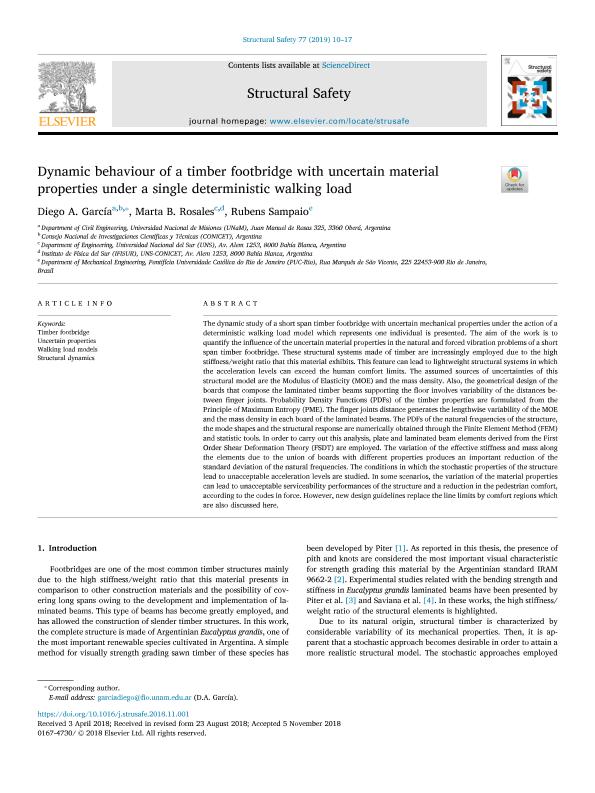Artículo
Dynamic behaviour of a timber footbridge with uncertain material properties under a single deterministic walking load
Fecha de publicación:
11/2018
Editorial:
Elsevier Science
Revista:
Structural Safety
ISSN:
0167-4730
Idioma:
Inglés
Tipo de recurso:
Artículo publicado
Clasificación temática:
Resumen
The dynamic study of a short span timber footbridge with uncertain mechanical properties under the action of a deterministic walking load model which represents one individual is presented. The aim of the work is to quantify the influence of the uncertain material properties in the natural and forced vibration problems of a short span timber footbridge. These structural systems made of timber are increasingly employed due to the high stiffness/weight ratio that this material exhibits. This feature can lead to lightweight structural systems in which the acceleration levels can exceed the human comfort limits. The assumed sources of uncertainties of this structural model are the Modulus of Elasticity (MOE) and the mass density. Also, the geometrical design of the boards that compose the laminated timber beams supporting the floor involves variability of the distances between finger joints. Probability Density Functions (PDFs) of the timber properties are formulated from the Principle of Maximum Entropy (PME). The finger joints distance generates the lengthwise variability of the MOE and the mass density in each board of the laminated beams. The PDFs of the natural frequencies of the structure, the mode shapes and the structural response are numerically obtained through the Finite Element Method (FEM) and statistic tools. In order to carry out this analysis, plate and laminated beam elements derived from the First Order Shear Deformation Theory (FSDT) are employed. The variation of the effective stiffness and mass along the elements due to the union of boards with different properties produces an important reduction of the standard deviation of the natural frequencies. The conditions in which the stochastic properties of the structure lead to unacceptable acceleration levels are studied. In some scenarios, the variation of the material properties can lead to unacceptable serviceability performances of the structure and a reduction in the pedestrian comfort, according to the codes in force. However, new design guidelines replace the line limits by comfort regions which are also discussed here.
Archivos asociados
Licencia
Identificadores
Colecciones
Articulos(CCT - NORDESTE)
Articulos de CTRO.CIENTIFICO TECNOL.CONICET - NORDESTE
Articulos de CTRO.CIENTIFICO TECNOL.CONICET - NORDESTE
Articulos(IFISUR)
Articulos de INSTITUTO DE FISICA DEL SUR
Articulos de INSTITUTO DE FISICA DEL SUR
Citación
Garcia, Diego Alberto; Rosales, Marta Beatriz; Sampaio, Rubens; Dynamic behaviour of a timber footbridge with uncertain material properties under a single deterministic walking load; Elsevier Science; Structural Safety; 77; 11-2018; 10-17
Compartir
Altmétricas




